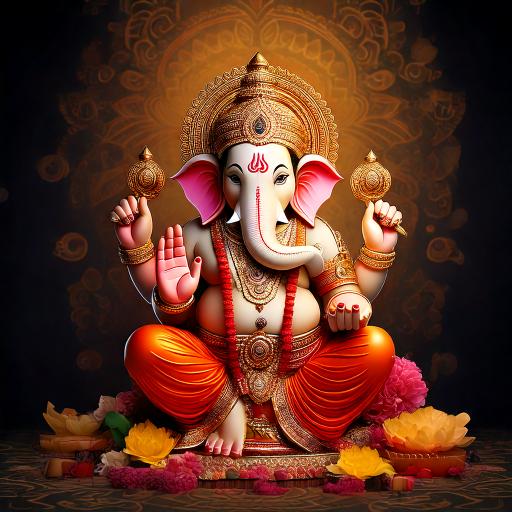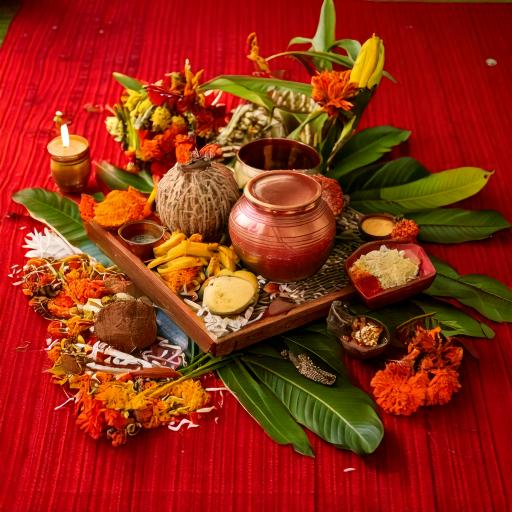Ganesh Puja
Introduction

Lord Ganesh, the remover of obstacles and the god of wisdom, is worshipped to seek blessings for success, prosperity, and the removal of challenges in life. Ganesh Puja, especially during Ganesh Chaturthi (also known as Vinayaka Chaturthi), celebrates his birth and is performed to invite divine blessings, bring harmony, and achieve spiritual and material growth. The puja holds great significance as it cleanses negative energies, promotes new beginnings, and fosters peace in homes and hearts. By performing Ganesh Puja, devotees believe they open the door to a fresh start, overcoming hurdles in their personal and professional lives.
Significance of Ganesh Puja
Ganesh Puja is a celebration that holds deep spiritual significance. Lord Ganesha is revered as the remover of obstacles and the deity of new beginnings, prosperity, and wisdom. By performing Ganesh Puja, devotees seek blessings for a smooth and successful life journey. It is believed that worshiping Lord Ganesha helps eliminate negative energies, bringing positivity, good fortune, and happiness into one’s life. This puja is an auspicious way to seek divine guidance, protect one's home, and ensure success in personal and professional endeavors.
History of Ganesh Chaturthi
The history of Ganesh Chaturthi dates back to ancient times. The festival is believed to have been celebrated in Maharashtra in the 16th century by the Maratha king, Chhatrapati Shivaji. It gained popularity in the 19th century when the freedom fighter, Lokmanya Tilak, transformed the public celebration of the festival into a powerful tool to unite people against British rule. By celebrating the festival on a large scale, he aimed to foster a sense of nationalism and bring communities together. Over the years, Ganesh Chaturthi has become a widely celebrated festival across India, symbolizing unity, joy, and the devotion to Lord Ganesha.
Why is Lord Ganesha Worshipped?
Lord Ganesha is one of the most widely worshipped deities in Hinduism, and his worship is an integral part of many important occasions, including festivals, housewarmings, and new ventures. He is considered the deity of wisdom, intellect, and learning, and is especially revered by students, scholars, and professionals. Lord Ganesha’s elephant head symbolizes intelligence and his large ears represent the importance of listening. His broken tusk signifies sacrifice, and his pot-belly represents abundance and the fullness of life. Devotees seek Lord Ganesha's blessings for success, removal of obstacles, good health, and a prosperous future.
GANESH PUJA VIDHI
Step 1: Purify the Space Start by cleaning the area where you'll perform the puja. Sweep away any dust, mop the floor, and you can even add rose water or turmeric for extra purification. A clean space creates a peaceful environment, inviting Lord Ganesh into your home and setting the mood for a positive and sacred puja.
Step 2: Decorate the Puja Area Set up a small altar using a low wooden platform (Chonky) and cover it with a red cloth. Place a Kalash (a pot filled with water), mango leaves, and a coconut on the altar. Decorate the area with flowers, rangoli, and light diyas to create a festive, welcoming atmosphere for the puja.
Step 3: Place the Ganesh Idol Position the Ganesh idol on the altar, ensuring it faces either the east or north direction, as these are considered auspicious. Make sure the idol is placed securely and comfortably, allowing for easy offering of prayers and rituals during the puja.
Step 4: Arrange the Offerings Prepare a plate with all the necessary offerings for the puja. This includes traditional items like modaks (sweet dumplings), fruits, flowers, and other sacred offerings. Place them neatly in front of the Ganesh idol on the altar, ensuring everything is clean and organized for the ritual.

Step 5: Make a Sincere Vow (Sankalp) Begin the puja by making a heartfelt commitment to perform the rituals with devotion and focus. This is known as Sankalp. To do this, hold water in your right hand, while reciting the Sankalp mantra:
“Om Shri Ganeshaya Namah, Sankalpo me karishyami, Prarthana purvakam, Aadhya Ganesh puja, Sada sakala samruddhi, Asha siddhi karishye.” #This mantra signifies your intent and dedication towards completing the Ganesh puja with full devotion. After reciting, pour the water into a small vessel or plate, symbolizing your determination to complete the rituals.
Step 6: Prana Pratishtha (Invoking the Divine Energy) 1.Prana Pratishtha is the process of inviting Lord Ganesha’s divine energy into the idol. This step makes the idol spiritually active, allowing Lord Ganesha to bless your home. 2.Start by offering water to the idol, symbolizing purification. 3.Pray to Lord Ganesha, asking him to reside in the idol and bring blessings of prosperity, health, and success. 4.Once done, the idol is ready to receive offerings and rituals, making it a true representation of Lord Ganesha's presence.
Step 7: Shodashopachara Puja Shodashopachara Puja involves 16 key rituals that honor Lord Ganesha. Start by inviting Him into your space with a moment of meditation (Dhyanam) and formal invocation (Avahanam). Offer Him a seat (Asanam) to welcome Him. Wash His feet and hands with water (Padyam, Arghyam, Achamanyam), followed by offering sweet items like honey, ghee, and curd (Madhuparkam). Bathe the idol with water (Snanam), then dress Him in new clothes (Vastram). Offer a sacred thread (Yagnoveetam) and adorn Him with jewelry (Abharanam). Apply sandalwood paste, kumkum, and other fragrant substances (Gandham) and decorate Him with flowers (Pushpam). Light incense (Dhoopam) and a lamp (Deepam), and offer Him fresh food (Naivedyam). These rituals express devotion and respect for Lord Ganesha, ensuring a sacred and joyful worship.
Step 8: Naivedyam (Offering Food to Lord Ganesha) Naivedyam refers to offering food to Lord Ganesha as an expression of love and devotion. This includes offering freshly prepared sweets like modaks, fruits, and other food items. The food offerings symbolize sharing the fruits of your hard work and efforts with the Lord. Once the food is offered, it is considered blessed, and the Prasadam can be shared with family members and devotees.
Step 9: Aarti (Performing the Aarti) The Aarti is an important part of Ganesha Puja. Light a diya or lamp and wave it around Lord Ganesha’s idol in a circular motion, moving in a clockwise direction. Chant the Ganesh Aarti or any other devotional song dedicated to Lord Ganesha. The sound of the Aarti, combined with the light of the lamp, creates a spiritual atmosphere and honors Lord Ganesha's presence in your home. This step symbolizes expressing gratitude and devotion to the Lord.
Step 10: Pradakshina (Circumambulation) After the Aarti, walk around the idol of Lord Ganesha in a clockwise direction, typically three times. This ritual, known as Pradakshina, is done to honor Lord Ganesha and seek his blessings. It represents the belief that everything moves around the divine presence, and by circling the idol, the devotee shows respect and devotion to Lord Ganesha.
Step 11: Blessings (Receiving Lord Ganesha’s Blessings) After completing the Aarti and Pradakshina, sit in a quiet place, close your eyes, and pray for Lord Ganesha’s blessings. You can ask for health, wealth, wisdom, and the removal of obstacles. Take a moment to reflect on his grace and guidance. You can offer your personal wishes and express gratitude for his divine protection.
Step 12: Prasadam (Distributing Prasadam) Finally, distribute the Prasadam (blessed food offerings) to the family members, friends, and devotees. It is believed that sharing the Prasadam brings blessings of prosperity and peace to all. Everyone who receives Prasadam also receives Lord Ganesha’s blessings. The offering may include sweets, fruits, and any other items offered during the puja
CONCLUSION
Ganesh Puja is a powerful ritual that connects devotees with Lord Ganesha, the remover of obstacles and harbinger of wisdom and prosperity. Through its meaningful rituals, it brings positivity, success, and new beginnings. Celebrated with devotion, Ganesh Chaturthi fosters unity and peace, helping to invite blessings into our lives. May Lord Ganesha's grace lead you toward a path of happiness, health, and success.




